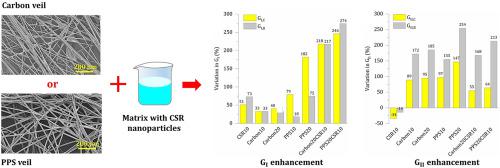Polymer ( IF 4.1 ) Pub Date : 2022-06-18 , DOI: 10.1016/j.polymer.2022.125081 Sheng Wang , Mehmet Çağatay Akbolat , Kali Babu Katnam , Zhenmin Zou , Prasad Potluri , Stephan Sprenger , James Taylor

|
This paper investigates the effect of non-hybrid and hybrid toughening, via core-shell rubber (CSR) nanoparticles and non-woven micro-fibre veils, on the delamination resistance and crack migration in carbon fibre/epoxy laminates under mode-I and mode-II conditions—with an emphasis on the effect of veil fibre properties on toughening mechanisms and fracture energies. Core-shell rubber particles, varying in size from 100 nm to 3 μm, with 0–10 wt% content, are dispersed within the epoxy resin. Two non-woven veils with contrasting fibre properties (i.e. one with ∼6 mm (50 wt%) and ∼12 mm (50 wt%) short carbon fibres and another with ∼6 mm short polyphenylene sulfide (PPS) fibres) with 10 g/m2 areal weights are used to introduce hybrid toughening at the interlaminar region. Carbon fibre/epoxy laminates with five different toughening routes (i.e. CSR toughening, carbon veil toughening, PPS veil toughening, carbon veil and CSR hybrid toughening, and PPS veil and CSR hybrid toughening) are manufactured with a two-part resin using vacuum infusion and out-of-autoclave curing. Double cantilever beam (DCB) and four-point end-notch-flexure (4-ENF) specimens are tested for mode-I and mode-II fracture energies and R-curves. Fracture surfaces are investigated to characterise crack migration and energy dissipation mechanisms. The results indicate that mode-I and mode-II fracture energies are significantly enhanced (e.g. ∼275% in initiation and propagation under mode-I) with the combined core-shell rubber nanoparticle and veil toughening investigated—significantly altering micro-failure mechanisms, crack paths and R-curves. It is shown that the low modulus PPS fibre veils together with CSR particles provide stable crack growth, while high modulus carbon fibre veils with CSR particles lead to unstable crack growth.
中文翻译:

具有核壳橡胶纳米颗粒和微纤维面纱混合增韧的碳/环氧树脂层压板的 R 曲线行为:碳与 PPS 面纱
本文研究了通过核壳橡胶 (CSR) 纳米粒子和非织造微纤维面纱的非混合和混合增韧对模式 I 和模式下碳纤维/环氧树脂层压板的抗分层和裂纹迁移的影响-II 条件——强调面纱纤维特性对增韧机制和断裂能的影响。核壳橡胶颗粒的尺寸从 100 nm 到 3 μm 不等,含量为 0-10 wt%,分散在环氧树脂中。两种具有对比纤维特性的无纺布面纱(即一种具有 ∼6 mm (50 wt%) 和 ∼12 mm (50 wt%) 短碳纤维,另一种具有 ∼6 mm 短聚苯硫醚 (PPS) 纤维),重量为 10 g /m 2面积权重用于在层间区域引入混合增韧。碳纤维/环氧树脂层压板具有五种不同的增韧路线(即CSR 增韧、碳面纱增韧、PPS 面纱增韧、碳面纱和 CSR 混合增韧以及 PPS 面纱和 CSR 混合增韧),由两部分树脂使用真空灌注和高压釜外固化。测试双悬臂梁 (DCB) 和四点末端缺口弯曲 (4-ENF) 试样的模式 I 和模式 II 断裂能和 R 曲线。研究断裂表面以表征裂纹迁移和能量耗散机制。结果表明,模式 I 和模式 II 断裂能显着增强(例如. 在模式-I 下,约 275% 的引发和扩展,并研究了核壳橡胶纳米颗粒和面纱增韧的组合——显着改变了微失效机制、裂纹路径和 R 曲线。结果表明,低模量 PPS 纤维幕与 CSR 颗粒一起提供稳定的裂纹扩展,而高模量碳纤维幕与 CSR 颗粒一起导致不稳定的裂纹扩展。









































 京公网安备 11010802027423号
京公网安备 11010802027423号